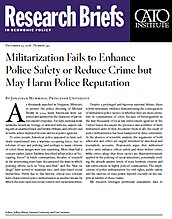To some people, American police appeared to have suddenly transformed into a wartime occupying force—but to scholars of race and policing (and perhaps to many citizens of color) these images were less surprising. More than half a century earlier, James Baldwin described urban police as “occupying forces” in black communities; decades of research in the intervening years have documented the ways in which policing efforts such as “stop-and-frisk” and the “war on drugs” have served to maintain race- and class-based social hierarchies. Partly due to this history, critical race scholars have characterized police militarization as another means by which the state exercises social control over racial minorities.
Despite a prolonged and vigorous national debate, there is little systematic evidence demonstrating the consequences of militarized police tactics or whether they are more prevalent in communities of color; because of heterogeneity in the way thousands of local law enforcement agencies in the United States document the presence and activities of their militarized units (if they document them at all), the study of police militarization has been hampered by data constraints. In the absence of scientific analysis, the arguments of both advocates and critics are largely informed by anecdotal and journalistic accounts. Proponents argue that militarized police units enhance officer safety and deter violent crime, while critics allege that these tactics are disproportionately applied in the policing of racial minorities, potentially eroding the already anemic levels of trust between citizens and law enforcement in highly policed communities. The implications of police militarization for civil rights, public safety, and the exercise of state power depend crucially on the empirical validity of these claims.
My research leverages previously unavailable data to describe the communities affected by militarized policing and to estimate its effects on crime, officer safety, and public perceptions of police. I first use a rare census of SWAT team deployments in Maryland to characterize the ways in which militarized police units are used and the characteristics of the communities in which they are deployed. I show that militarized police units are more often deployed in communities with high concentrations of African Americans, a relationship that holds at multiple levels of geography and even after controlling for social indicators including crime rates. I then use an original nationwide panel measuring the presence of active SWAT teams in roughly 9,000 U.S. law enforcement agencies, as well as the Maryland SWAT deployment data, to test whether militarized policing lowers crime rates and promotes officer safety. Using intra-agency comparisons that greatly mitigate concerns over omitted variable bias, I find no evidence that obtaining or deploying a SWAT team reduces local crime rates or lowers the rates at which officers are killed or assaulted.
Finally, using survey experiments that randomly assign images of police officers in news reports, I show that seeing more militarized officers—relative to traditionally equipped police—can inflate perceptions of crime and depress support for police funding and presence. This analysis includes a large oversample of African American respondents—an important feature given the high rate at which militarized police units are deployed in black neighborhoods.
On average, militarized police units do not appear to provide the safety benefits that many police administrators claim they do. Police may suffer reputational damage when they deploy militarized units. These results suggest that the often-cited tradeoff between public safety and civil liberties is, in the case of militarized policing, a false alternative.
Given the concentration of deployments in communities of color, where trust in law enforcement and government at large is already depressed, the routine use of militarized police tactics by local agencies threatens to increase the historic tensions between marginalized groups and the state, with no detectable public safety benefit. While SWAT teams arguably remain a necessary tool for violent emergency situations, restricting their use to those rare events may improve perceptions of police with little or no safety loss.
NOTE:
This research brief is based on Jonathan Mummolo, “Militarization Fails to Enhance Police Safety or Reduce Crime but May Harm Police Reputation,” Proceedings of the National Academy of Sciences 115, no. 37, September 11, 2018, http://www.pnas.org/content/115/37/9181.
